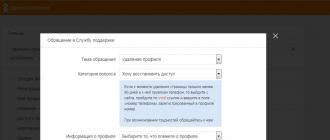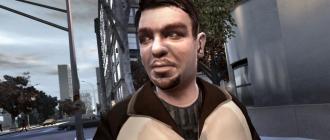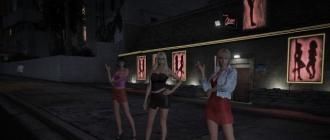Flash CS3 Tutorial
Decorated as electronic textbook- tutorial in the format CHM(compressed hypertext). Tutorial contains 16 lessons, which cover all the main features of the environment Adobe Flash CS3 . In addition, the text of the textbook contains practical tasks With step by step instructions and a detailed explanation of all actions.
The Appendix provides background information on the basics of the language ActionScript 2.0.
The proposed approach can be formulated as “from problem to theory”. All tools and techniques for working in the environment Flash are considered in the textbook not in isolation, but in the context of practical tasks that arise when creating animated videos.
The first part of the textbook (topics 1-6) is quite accessible for students to study 5-8 grades. For the normal development of the rest of the material, it is desirable to be familiar with trigonometric functions and the basics of vector mathematics.
To study the second part of the textbook, students should have some basic knowledge of basics of programming(variables, loops, conditional statements, functions). Because language ActionScript very similar to Xi And JavaScript, knowledge of these languages will greatly facilitate life and allow you to focus on Flash.
Although in Adobe Flash CS3 programming language introduced ActionScript 3.0, according to the author, it is inappropriate to use it in a textbook intended for schoolchildren. The new version of the language requires a more abstract approach and is of interest mainly to the professional public.
In the preparation of materials, a trial English version programs Adobe Flash CS3, which can be downloaded for free from (you must first register on the site, this is also free).
Good Books on Flash
- Official training course. Adobe CS3 Professional. - M: Triumph, 2008.
- Mook K.. . - St. Petersburg: Peter, 2009.
- Vander Veer E.A., Grover K.. Flash CS3. The missing guide. - St. Petersburg: BHV-Petersburg, 2008.
- Packnell S., Hogg B., Swann K.. Macromedia Flash 8 for Professionals. - St. Petersburg: Williams, 2006.
- Bhangal Sh.. flash. Tricks. 100 tips and tricks from a pro. - St. Petersburg: Peter, 2005.
License agreement
- 1) publishing materials in any form, including posting materials on other Web sites;
- 2) distribution of incomplete or altered materials;
- 3) inclusion of materials in collections on any media;
- 4) obtaining commercial benefits from the sale or other use of materials.
Downloading materials means that you have accepted the terms of this license agreement.
Elective courses
Based on the textbook, two elective courses, which are actually two parts of one course. Their total duration is 54 hours.
The courses can be used for profile training of students in the classes of physics and mathematics, information technology and other profiles.
Application of a programming language ActionScript while creating Flash-roller lets you take full advantage of the environment Adobe Flash CS3, get absolute control over the playback of the movie and solve problems that are extremely difficult or impossible to solve without program code. In a training course based on the second part of the textbook, in a simple and accessible way, using many practical examples, the basics of programming in ActionScript 2.0.
Illustration
As an illustration of the possibilities Flash traditionally, a cube is often used, which can be rotated both with the mouse and with the arrow keys (by first clicking on it). Clicking on the small cube returns the large one to its original position. The self-study tutorial has all the information you need to create such a cube.
Getting to know the program interface
Adobe* FLASH* CS3 PROFESSIONAL
Beginners and very willing - help.
Install Adobe* FLASH* CS3 PROFESSIONAL, for initial study, this version is the most suitable, (you can find it on the Internet, you can write me a letter, I will send it to you by mail)
The study of any program begins with getting to know the interface of the program, but for effective development, you need to have an idea of what allows you to create this remedy, and the next step is how to do it.
Download a wonderful book Ethan Watrall and Norbert Herbert- containing a description of the Flash interface
Who needs this book
“All men, women and children on our planet need this book! But seriously, it's probably impossible to write a book that everyone needs. However, we have made every effort to ensure that our work finds as many supporters as possible. The topics have been carefully selected and covered so that the material can be used by different people with different levels of knowledge and experience. As a last resort, if you don't like the contents of the book, you can put it under a wobbly bed leg or use it successfully as a good door stop. Although this book is not intended for developers who have extensive experience with Flash, we would not it is quite the opposite! After all, a lot of material has been collected here, with which even experienced users may be unfamiliar. We think that everyone who wants to be a part of the Flash Revolution should read this book. This group of people includes students who want to post projects on the Web, animators or artists who want to submit their work to digital format, anyone who is frustrated by the limited possibilities of HTML, and anyone who is interested in vector animation and interactivity. In a word, those who are interested in the limitless possibilities and phenomenal power of Flash, but who do not know where to start. If you are one of those people, this book is for you! (quote from the book)
Do not be afraid of the abundance of opportunities, Flash is remarkable in that you can start creating your own works, with almost zero knowledge, and as your appetite comes, you will move forward.
WARNING:
The book has one small drawback - it is too detailed, do not read everything, but look for the item you need.
FLASH Tutorial by Ethan Wattrall and Norbert Herbert, size 28.8 MB pdf format
Go ahead, good luck to you
"COMPUTER ANIMATION
IN ADOBE FLASH »
(18 hours)
Author-compiler:
POLYAKOV Konstantin Yurievich ,
IT-teacher,
Doctor of Technical Sciences _____________________________
ANNOTATION
Animation - ("animation" of images) is an important means for conveying information. Animated videos and videos, when used correctly, can significantly increase the effectiveness of training, as well as serve as an excellent illustration for reports and presentations. In addition, the creation of animation clips - important way development of creative abilities of schoolchildren.
Computer technology provides ample opportunities in the field of animation, which were previously available only to professionals. Training course"Computer Animation inAdobe Flash» provides an opportunity to learn the techniques of creating computer animated films in the environmentAdobe Flash CS3 . The material of all lessons is designed in the form of an electronic textbook, including a theoretical part and practical tasks. The main emphasis is not on the mechanical execution of algorithms, but on the understanding of the processes occurring in this process.
EXPLANATORY NOTE
” is included in the educational field “informatics”. It includesFlash AdobeTraining course "Computer animation in18 hoursclassroom and (if possible) independent work of students. The course can be used for profile training of students in the classes of physics and mathematics, information technology, socio-humanitarian and other profiles.
The subject of study is the principles and methods of creating animated videos using the environmentAdobe Flash CS3 , which in this moment is one of the most powerful authoring tools in this area.
The expediency of studying this course is determined by the rapid introduction of digital technology into everyday life and the transition to new information processing technologies. Students learn the basic skills of creating animated films, which are necessary for their successful implementation in the modern world.
Course Objectives:
- introduce students to modern principles and methods of creating animated films based on the use vector graphics;
- to develop the creative and design abilities of students.
Course objectives: teach schoolchildren
- create vector drawings in the environmentAdobe Flash CS3
- use environmentAdobe Flash CS3 to create animated films
This course has a pronounced practical orientation, which determines the logic of building the material of training sessions.
The main form of training is the workshop. For normal operation needed Personal Computer(one per student) and WednesdayAdobe Flash CS3 . For most tasks, it is enough to use more than old version environments:Macromedia Flash 8 . Test version environmentsAdobe Flash CS3 (with a limited period of use) can be downloaded for free from Company website Adobe:
http://www.adobe.com/ru/downloads/?ogn=RU-gntray_dl_trialdownloads_ru
To support the course, the author has developed an electronic tutorial in the format CHM , which contains theoretical material and tasks to perform practical work. It is used during lessons for self-study and as a reference. This allows you to successfully organize classes in groups in which there are students with different rates of mastering the material.
Knowledge gained during the course "Computer animation inAdobe Flash CS3 ”, students can use to prepare high-quality illustrations for reports and multimedia developments in various subjects - mathematics, physics, chemistry, biology, etc. Videos created in the editorAdobe Flash CS3 , can also be used to create Web-pages. The acquired knowledge and skills are the basis for the subsequent study of three-dimensional modeling, video editing, and the creation of virtual reality systems.
Expected results
As part of this course, students acquire the following knowledge and skills:
- understand the principles of vector and raster coding graphic information in computer technology;
- understand the principles of working with the timeline;
- able to work with multi-layered documents;
- know how to create animated videos;
- know how to use sound files to accompany the animation.
Summing up forms
The current control of the level of assimilation of the material is carried out according to the results of the students' performance of practical tasks at each lesson. At the end of the course, each student completes an individual project as a test. At the last lesson, a conference is held at which students present their work and discuss it.
COURSE CONTENT
Section 1 Introduction
Topic 1. Acquaintance withAdobe Flash CS3 download unzip-run index
another little tutorial
Methods of encoding graphic information in raster and vector formats are compared. Examining the location of the environment panels Adobe Flash CS3 and basic techniques for working with the finished film. Work on the topic in the textbook familiarity with flash
Section 2. Drawing
Topic 1. Contours
Students are introduced to basic path drawing tools. Panel under study color, principles of contour editing using tools Selection And subselection.
contours (before filling)
Topic 2. Fills
Fills and methods of working with them are studied, tools Brush And Eraser.
Work through the textbook topic contours (fill)
Topic 3. Geometric shapes
Geometric shapes are studied - rectangle, oval, polygon, figures with customization. Particular attention is paid to the difference between the merge mode and the object drawing mode.
Work through the textbook topic Geometric figures,
Section 3. Animation
Topic 1. Frame-by-frame animation
Learn how to create and edit frame-by-frame animation. Students get acquainted with the transformations of objects on the stage, in the practical part they create an animated video using all the previous material. Work through the textbook topic "frame-by-frame animation". do practice-bear
Topic 2. Form Animation
Learn how to animate shapes for fills and paths. The concept of a layer and multilayer documents is introduced. The simplest methods of using sound, text effects are being studied.
Work through the textbook topic Shape Animation
tasks
Introduction - changing the square
Checkpoints- circle to square
Contour Optimization - Square to Butterfly
Color and movement - two rectangles
Layers - rectangle and oval
Sound
Text-URA, St. Petersburg
Layers-masks-all tasks in the tutorial
Topic 3. Motion Animation
Students are introduced to the concept of a symbol and use examples to learn how to animate motion. Practical tasks use raster drawings and sound effects.
Work through the textbook topic Symbols, motion animation
Practice:
- Symbols - ball
- Motion animation - ball movement
- Change character on animation change ball on bounce
- Guides - ball in the basket
- Spin - the ball is spinning
- Raster drawings typewriter
- Orientation along the path - car on the grass
- Nested animation-machine through the mountains
- Changing animation speed
- Animation of the text - according to the task in the textbook
Section 4. Project execution
During 4 lessons, students complete a project on a chosen topic. This could be, for example,
- ads
- presentation of a book or film
- possible results:
An animation is a sequence of frames shown at a fast pace, each of which is slightly different from the one that preceded it and the one that follows it. Each frame is displayed for a certain amount of time.
Currently, there are several technologies for creating animation: GIF animation format, Flash, Java and JavaScript.
Technology Benefits Flash . Compared to GIF-animation, the possibilities of Flash technology are much wider.
Flash Technology
allows you to create navigation elements, animated logos, full-scale voiced cartoons, and even entire sites with a wide variety of interactive elements.
Thanks to the vector graphics used by Flash, animations are small in size and therefore load quickly and adjust to the size of the browser window.
Flash technology fully satisfies the requirements of Web designers for tools for preparing graphics, providing a program for creating vector graphics and animation - Adobe (Macromedia) Flash.
Animated videos created by this program are called movies. Moreover, the animation capabilities of the program are not limited only to animation - you can animate everything, including also navigation elements and menus.
Flash is not limited to creating animations just for the Web. You can also create and distribute movies on CD or via e-mail using the standalone FlashPlayer.
Can export movies to other formats such as QuickTime (MOV) or Windows AVI.
The presence of the ActionScript language for developing interactive elements.
!ABOUT main purpose Adobe software(Macromedia) Flash - development of interactive Web-sites.
Historical reference. Flash started out as a small vector graphics and animation program called Future Splash Animator. In 1997, Macromedia acquired Future Splash Animator, changed its name to Flash, and introduced the program as a graphics preparation tool for world wide Web. Macromedia Flash stands out among the programs for preparing vector graphics for the Web in that it includes everything necessary tools: to create graphics, to animate prepared images, to design interactive elements, to generate the HTML code needed to place a Flash movie on a Web page and view it with a browser.
Under this name, the platform continues to develop to this day (although after Macromedia was acquired by Adobe in 2005, Macromedia Flash became officially known as Adobe Flash).
The purchase of Macromedia allowed Adobe to further strengthen its position in the graphic and multimedia software market, having in its line a full range of software products necessary for both a professional designer and web developer, and a novice specialist in this field. Now the Adobe portfolio will be replenished with such solutions as Adobe Design Bundle (includes all products included in Adobe Creative Suite 2 Premium plus Macromedia Flash Professional 8), Adobe PDF and Macromedia Flash in one package, Adobe Web Bundle (includes all products included in Adobe Creative Suite 2 Premium plus Macromedia Studio 8), and Macromedia Studio 8 web design and development solution can now work in a single Adobe Creative Suite 2 Premium environment .






